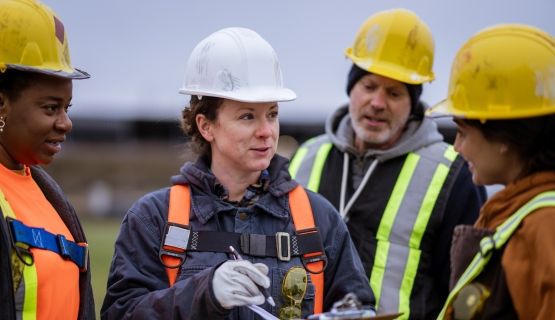Illness/injury prevention
IWH has a long history of conducting research to provide practical guidance to employers, workers, OHS professionals and regulators about what works and what doesn’t in injury or illness prevention. This research targets the injury and illness prevention practices of workplaces, as well as the programs developed by governments, health and safety associations and others to support and motivate workplaces to adopt effective practices.
Featured

At Work article
Differences in firm-level AI use for health and safety
To what extent are Canadian workplaces using artificial intelligence (AI) to help support workers’ health and safety? And what do these workplaces have in common? An IWH study surveyed firms across Ontario and British Columbia to find out.
Published: October 8, 2025

Impact case study
Saskatchewan’s construction safety group uses IWH tool to improve safety culture
This case study details how the Saskatchewan Construction Safety Association (SCSA) members have been analyzing IWH-OPM scores to adjust their safety practices and how SCSA has been using the data to tailor their outreach.
Published: February 10, 2025

At Work article
What can work-related COVID-19 cases tell us about how to prepare for the next pandemic?
To what extent did workplace exposures account for the transmission of the COVID-19 virus during the first two years of the pandemic? A new study by IWH combined data sources to estimate work-related infection rates, using a method that took into account major shifts in where people worked. It found the role of work exposure changed from wave to wave, in a dynamic pattern not in keeping with the number of cases in the general population.
Published: February 2024
Journal article
Journal article
Variation in occupational exposure risk for COVID-19 workers' compensation claims across pandemic waves in Ontario
Published: Occupational & Environmental Medicine, February 2024
IWH Speaker Series
IWH Speaker Series
Refining estimates of occupational exposures and risk of workplace COVID-19 transmission
The COVID-19 pandemic shone a light on the importance of having accurate data on workplace exposure to infectious diseases. Efforts to estimate infection rates of COVID-19 during the public health emergency were hampered by inadequate information on key factors, such as whether an infected worker had worked from home or interacted with the public. In this presentation, Dr. Peter Smith shares results from a study that examined the risk of work-related COVID-19 infections. He discusses methods used by the team to combine data sources to take into account changes in labour market participation—including working from home—during different phases of the COVID-19 pandemic.
Published: January 2024
Journal article
Journal article
Evaluation of the Ontario mandatory working-at-heights training requirement in construction, 2012 - 2019
Published: American Journal of Public Health, January 2024

Impact case study
IWH evaluation of the effectiveness of the Ontario working-at-heights training standard
An IWH study on the effectiveness of Ontario's mandatory training was helpful to the labour ministry in several ways—including in reinforcing the value of program evaluations.
Published: November 2023

IWH in the media
Study shows worker injuries due to falls from heights declined after Ontario made training standardized and mandatory
Among recent organized efforts to make jobsites safer, working-at-heights training has been effective, reports an Institute for Work & Health (IWH) study. As Adam Freill reports, in the three-year period after Ontario made working-at-heights training in the construction sector standardized and mandatory, study authors explain that the rate of fall-from-height injuries leading to time off work fell by 19 per cent.
Published: On-Site Magazine, November 2023
News release
News release
Worker injuries due to falls from heights declined after Ontario made training standardized and mandatory, study finds
Published: November 2023

At Work article
Safer work practices, lower injury rates maintained two years after Ontario’s working-at-heights training came into effect: study
In 2015, the Ontario government implemented a working-at-heights (WAH) training standard to ramp up fall prevention efforts. An IWH study team has now gathered two additional years of data on the effectiveness of this training requirement—both on work practices and injury rates.
Published: November 2023

IWH in the media
Climate change could mean longer hours, stagnating wages
Extreme weather caused by climate change is changing the jobs of health care workers, outdoor labourers, and even flight attendants, writes Gabriela Calugay-Casuga. Research from IWH about the union safety effect is cited.
Published: Rabble.ca, August 2023

IWH in the media
Cannabis use during work raises workplace injury odds, research shows
A study by the Institute for Work & Health (IWH) has shed light on the association between cannabis use and work injury risk. As reported by Ada Tabanao, by distinguishing between on-the-job cannabis consumption and off-duty use, researchers found a significant difference in injury risks.
Published: Benefits and Pensions Monitor, August 2023